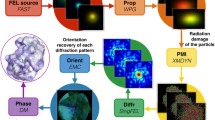Abstract
NIST DTSA-II is a free, open access, and fully-documented comprehensive software platform for electron-excited X-ray microanalysis with energy dispersive spectrometry (EDS), including tools for quantification, measurement optimization, and spectrum simulation. EDS simulation utilizes a Monte Carlo electron trajectory simulation that includes characteristic and continuum X-ray generation, self-absorption, EDS window absorption, and energy-to-charge conversion leading to peak broadening. Spectra are simulated on an absolute basis considering electron dose and spectrometer parameters. Simulated and measured spectra agree within ± 25% relative for K-shell and L-shell characteristic X-ray peaks from 1 to 11 keV, while the predicted M-shell intensity was found to exceed the measured value by a factor of 1.4–2.2 from 1 to 3 keV. The X-ray continuum (bremsstrahlung) intensity agreed within ± 10% over the photon energy range from 1 to 10 keV for elements from boron to bismuth. Simulated spectra can be used to develop analytical strategy, such as assessing detection of trace constituents.
Graphical abstract




Similar content being viewed by others
Data availability
Data available at: https://datapub.nist.gov/od/id/mds2-2608.
Code availability
NIST DTSA-II software available at: https://www.nist.gov/services-resources/software/nist-dtsa-ii.
References
J. Goldstein, D. Newbury, J. Michael, N. Ritchie, J. Scott, D. Joy, Scanning Electron Microscopy and X-ray Microanalysis, 4th edn. (Springer, New York, 2018)
Ritchie, N.W., DTSA-II open access software for quantitative electron excited X-ray microanalysis with energy dispersive spectrometry; available for free, including tutorials, at the NIST website: https://www.nist.gov/services-resources/software/nist-dtsa-ii (2021).
D. Newbury, N. Ritchie, Review: performing elemental microanalysis with high accuracy and high precision by scanning electron microscopy/silicon drift detector energy dispersive X-ray spectrometry (SEM/SDD-EDS). J. Mater. Sci. 50, 493–518 (2015)
D.E. Newbury, N.W.M. Ritchie, An Iterative qualitative-quantitative sequential analysis strategy for electron-excited X-ray microanalysis with energy dispersive spectrometry: finding the unexpected needles in the peak overlap haystack. Microsc. Microanal. 24, 350–373 (2018)
D.E. Newbury, N.W.M. Ritchie, Quantitative electron-excited X-ray microanalysis of borides, carbides, nitrides, oxides, and fluorides with scanning electron microscopy/silicon drift detector energy-dispersive spectrometry (SEM/SDD-EDS) and DTSA-II. Microsc. Microanal. 21, 1327–1340 (2015)
D.E. Newbury, N.W.M. Ritchie, Electron-excited X-ray microanalysis at low beam energy: almost always an adventure! Micros. Microanal. 22(4), 735–753 (2016)
D.E. Newbury, N.W.M. Ritchie, Measurement of trace constituents by electron-excited X-ray microanalysis with energy-dispersive spectrometry. Microsc. Microanal. 22, 520–535 (2016)
N.W.M. Ritchie, Spectrum simulation in DTSA-II. Microsc. Microanal. 15, 454–468 (2009)
J.-L. Pouchou, F. Pichoir, Quantitative analysis of homogeneous or stratified microvolumes applying the model “PAP, in Electron Probe Quantitation. ed. by K.F.J. Heinrich, D.E. Newbury (Plenum, New York, 1991), p. 31
J.A. Small, S.D. Leigh, D.E. Newbury, R.L. Myklebust, Modeling of the bremsstrahlung radiation produced in pure-element targets by 10–40 keV electrons. J. Appl. Phys. 61, 459–469 (1987)
D. Bote, F. Salvat, Calculations of inner-shell ionization by electron impact with the distorted-wave and plane-wave Born approximations. Phys. Rev. A 77(4), 042701 (2008)
C.T. Chantler, J. Phys. Chem. Ref. Data 24, 71 (1995). "Theoretical form factor, attenuation and scattering tabulation for Z=1–92 from E=1–10 eV to E=0.4–1.0 MeV."
C.T. Chantler, J. Phys. Chem. Ref. Data 29(4), 597–1048 (2000). "Detailed tabulation of atomic form factors, photoelectric absorption and scattering cross section, and mass attenuation coefficients in the vicinity of absorption edges in the soft X-ray (Z = 30–36, Z = 60–89, E = 0.1 keV-10 keV), Addressing Convergence Issues of Earlier Work."
L. Sabbatucci, F. Salvat, Theory and calculation of the atomic photoeffect. Radiat. Phys. Chem. 121, 122–140 (2016)
Cullen, D. E. (1992). Program RELAX: a code designed to calculate atomic relaxation spectra of X-rays and electrons (No. UCRL-ID-110438). Lawrence Livermore National Lab., CA (United States).
Williams, G. P. (1992). Electron binding energies of the elements. CRC Handbook of Chemistry and Physics, 92nd edition, Section, 10, 221–226.
NIST (https://www.nist.gov/srm) definitions for Standard Reference Materials, Certified Reference Materials, and Reference Materials.
International Organization for Standardization, standard ISO 22029:2003. https://www.iso.org/home.html.
Newbury, D.E. and Ritchie, N.W.M. “Energy dispersive X-ray spectrum simulation with NIST DTSA-II: comparing simulated and measured electron-excited spectra”, Microsc. Microanal. (in review).
Acknowledgements
This work was conducted by the authors as part of their official duties as employees of the National Institute of Standards and Technology of the US. Department of Commerce. Certain commercial equipment, instruments, or materials are identified in this paper to foster understanding. Such identification does not imply recommendation or endorsement by the National Institute of Standards and Technology, nor does it imply that the materials or equipment identified are necessarily the best available for the purpose.
Author information
Authors and Affiliations
Corresponding author
Ethics declarations
Conflict of interest
The authors certify that they have no conflicts of interest based on any aspect of this work.
Rights and permissions
About this article
Cite this article
Newbury, D.E., Ritchie, N.W.M. Simulating electron-excited energy dispersive X-ray spectra with the NIST DTSA-II open-source software platform. MRS Advances 7, 892–898 (2022). https://doi.org/10.1557/s43580-022-00300-8
Received:
Accepted:
Published:
Issue Date:
DOI: https://doi.org/10.1557/s43580-022-00300-8




